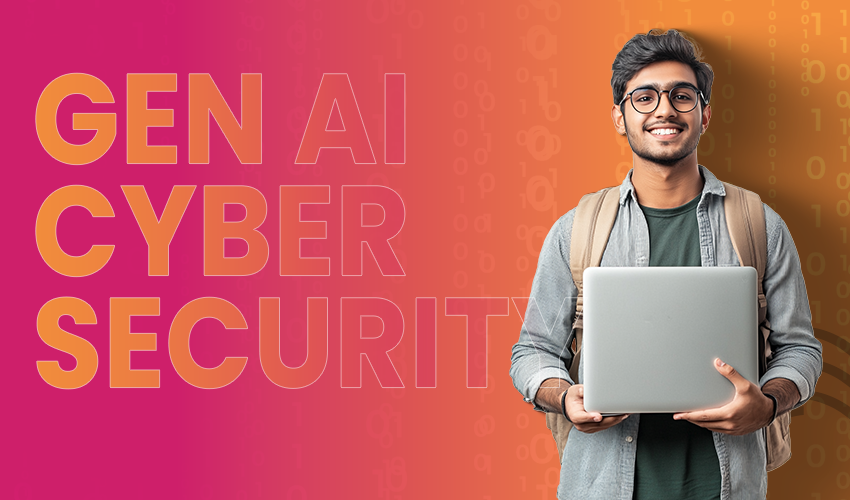AI-Powered Cyber Security Program

Get unlimited access to all learning content and premium assets Membership Pro
Learn how the world’s leading security teams protect systems, stop attacks, and safeguard millions of users — using a mix of traditional security practices and cutting-edge AI-driven defense.
This 12-week, beginner-friendly AI-Powered Cyber Security Programme teaches you the fundamentals of security, ethical hacking, and network defense, while integrating AI tools used in real Security Operations Centers (SOCs) — so you can detect threats faster, analyze incidents smarter, and respond with professional accuracy.
No prior cyber security experience required.
All you need is curiosity and the willingness to protect digital systems — we’ll teach you the tools, the techniques, and the AI-Enhanced Cyber Defense Mindset.
Why This Course?
Most courses only teach tools.
We teach you how cyber defenders think, analyze, and respond in real-world environments.
At GenAIversity, you’ll learn how top cybersecurity teams use:
SIEM Tools (Splunk, ELK, QRadar) for threat monitoring
EDR/XDR for endpoint defense
Kali Linux + Metasploit for ethical hacking
AI-based Analyzers for threat detection, log parsing & pattern recognition
Cloud Security Tools (AWS, Azure) for protecting modern infrastructure
You’ll finish the program with a portfolio of real-world cybersecurity projects — including penetration tests, SOC analysis reports, incident response simulations, and cloud security hardening tasks.
Future-Proof Your Job with GenAiVersity
Curriculum Breakdown
Module 1: Introduction to Cybersecurity & Networks
- Definition of cybersecurity
- Importance of securing networks
- Relationship between networking and security
- CIA Triad (Confidentiality, Integrity, Availability)
Module 2: Basics of Computer Networks
- Types of Networks: LAN, WAN, MAN, PAN
- Network Topologies: Bus, Star, Mesh, Hybrid
- Network Devices: Router, Switch, Firewall, IDS/IPS, Load balancer
- OSI Model (7 Layers) and how security applies at each layer
- TCP/IP Model (Application, Transport, Internet, Network Access)
Module 3: Common Network Protocols
Application Layer: HTTP/HTTPS, DNS, SMTP, FTP, SSH
Transport Layer: TCP, UDP
Network Layer: IP, ICMP, ARP
Security Protocols: SSL/TLS, IPSec, VPN, Kerberos
Module 4: Cybersecurity Threat Landscape
Malware: Viruses, Worms, Trojans, Ransomware, Spyware
Network Attacks: DoS/DDoS, MITM, Sniffing, ARP Spoofing, DNS Poisoning
Application Attacks: SQL Injection, XSS, CSRF
Insider Threats & Social Engineering: Phishing, Vishing, Smishing
Module 5: Network Security Mechanisms
Firewalls: Packet Filtering, Stateful, Next-Gen
IDS/IPS
NAC (Network Access Control)
VPN & Tunneling
Zero Trust Network Access (ZTNA)
Endpoint Security (EDR/XDR)
SIEM & SOC Operations
Module 6: Cryptography & Secure Communication
Symmetric Encryption: AES, DES
Asymmetric Encryption: RSA, ECC
Hashing: SHA, MD5, bcrypt
Digital Certificates & PKI
SSL/TLS Handshake
Email Security: SPF, DKIM, DMARC
Module 7: Secure Network Design & Architecture
Defense in Depth
Network Segmentation & VLANs
DMZ (Demilitarized Zone)
Secure Wi-Fi (WPA3, Radius)
Cloud Network Security: AWS, Azure, GCP
Hybrid & Multi-cloud Security
Module 8: Security Monitoring & Incident Response
Log Collection & Monitoring
Threat Intelligence
Incident Response Lifecycle
Preparation
Detection
Containment
Eradication
Recovery
Lessons Learned
Forensics in Network Security
Module 9: Compliance & Standards
ISO 27001
NIST Cybersecurity Framework
GDPR
HIPAA
PCI-DSS
CIS Controls
Module 10: Future Trends in Cybersecurity & Networks
AI/ML in Security
SASE (Secure Access Service Edge)
Quantum-safe Cryptography
IoT Security
5G Network Slicing Security
OT & ICS Security
Module 11: Cyber Security Best Practices
Multi-factor Authentication
Patch Management
Least Privilege
Network Monitoring & Anomaly Detection
Security Awareness Training
Module 12: Network Addressing & Subnetting
IPv4 vs IPv6
Subnetting & CIDR
Private vs Public IPs
NAT & PAT
Security importance of subnetting
Module 13: Network Services & Security
DNS Security: DNSSEC, DoH, DoT
DHCP Security
Email Security Protocols
Directory Services (LDAP, Active Directory)
NTP (Time Sync) & its importance in logs
Module 14: Advanced Network Protocols
BGP & BGP Hijacking
MPLS & VPN Security
802.1X Authentication
SDN & its security risks
Module 15: Wireless & Mobile Network Security
Wi-Fi Standards (WEP, WPA2, WPA3)
Rogue APs & Evil Twin Attacks
Bluetooth Attacks
5G Security Challenges
Module 16: Virtualization & Cloud Networking
VLANs
VPNs: Site-to-Site & Remote Access
Cloud Networking: VPCs (AWS), VNets (Azure), Subnets
Container Security (Docker, Kubernetes)
Module 17: Network Security Tools
Packet Analysis: Wireshark, tcpdump
Vulnerability Scanners: Nessus, OpenVAS
Pen-Testing Tools: Metasploit, Nmap, Burp Suite
Network Monitoring: Nagios, Zabbix, SolarWinds
SIEM: Splunk, QRadar, ELK
Module 18: Advanced Threats & Countermeasures
APTs
Zero-Day Exploits
Botnets & C2 Communication
Rogue Devices & BYOD
Insider Threat Detection
Module 19: Network Segmentation & Microsegmentation
VLAN-based segmentation
Firewall policies
Microsegmentation (Cloud & SDN)
Preventing lateral movement
Module 20: Emerging Security Technologies
SASE
ZTNA
XDR
Deception Technology (Honeypots, Honeytokens)
Quantum Networking & Post-Quantum Security
Module 21: Cyber Attacks – Classification
Active Attacks
Passive Attacks
Insider Attacks
External Attacks
Module 22: Network Attacks
DoS/DDoS
MITM
Packet Sniffing
ARP Poisoning
DNS Poisoning
IP Spoofing
Session Hijacking
Module 23: Application Layer Attacks
SQL Injection
XSS
CSRF
Command Injection
LFI/RFI
API Exploits
Module 24: Malware-Based Attacks
Viruses & Worms
Trojans
Ransomware
Spyware & Adware
Rootkits
Botnets
Module 25: Social Engineering Attacks
Phishing
Spear Phishing
Whaling
Smishing
Vishing
Pretexting & Baiting
Module 26: Advanced & Emerging Attacks
Zero-Day Exploits
APTs
Supply Chain Attacks
IoT Attacks
Cloud Attacks
Quantum Attacks (Future Risk)
Duration & Effort
Duration: 12 Weeks (120 Hours Total)
Format: Live Sessions + Guided Cyber Labs + Real Attack Simulations
Level: Intermediate to Advanced
Cohort Size: 50 Students
Certificate: Certified GenAIversity Hackathon
Assessment Methods
Weekly security lab assignments (AI-assisted + manual)
Peer-reviewed penetration testing reports
AI-driven threat detection & analysis evaluations
- Capstone project evaluation by industry mentors
Our Student Success Stories
Course Features
- Duration 120 hours
- Activities IT
- Class Sizes 25
- Available Seats 25
Get unlimited access to all learning content and premium assets Membership Pro
“GenAIversity turned my basics into real skills.”
In college, I only learned theory. At GenAIversity, I built end-to-end AI apps, mastered advanced coding, and gained confidence to face the job market.
— Jaya Shree, GenAIversity Student
You might be interested in
-
In-person class
-
All levels
-
SASI ICON Building, Madhapur Metro Station, Road No 36 & 37, Jubilee Hills, Telangana 500033
-
1 Student
-
10 lessons
-
In-person class
-
All levels
-
SASI ICON Building, Madhapur Metro Station, Road No 36 & 37, Jubilee Hills, Telangana 500033
-
1 Student
-
10 lessons
-
In-person class
-
Intermediate
-
SASI ICON Building, Madhapur Metro Station, Road No 36 & 37, Jubilee Hills, Telangana 500033
-
273 Students
-
60 lessons
-
In-person class
-
Intermediate
-
SASI ICON Building, Madhapur Metro Station, Road No 36 & 37, Jubilee Hills, Telangana 500033
-
273 Students
-
60 lessons
Sign up to receive our latest updates
Get in touch
Address

